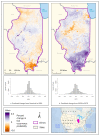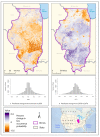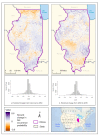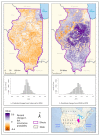Current and Future Habitat Suitability Models for Four Ticks of Medical Concern in Illinois, USA
- PMID: 36975898
- PMCID: PMC10059838
- DOI: 10.3390/insects14030213
Current and Future Habitat Suitability Models for Four Ticks of Medical Concern in Illinois, USA
Abstract
The greater U.S. Midwest is on the leading edge of tick and tick-borne disease (TBD) expansion, with tick and TBD encroachment into Illinois occurring from both the northern and the southern regions. To assess the historical and future habitat suitability of four ticks of medical concern within the state, we fit individual and mean-weighted ensemble species distribution models for Ixodes scapularis, Amblyomma americanum, Dermacentor variabilis, and a newly invading species, Amblyomma maculatum using a variety of landscape and mean climate variables for the periods of 1970-2000, 2041-2060, and 2061-2080. Ensemble model projections for the historical climate were consistent with known distributions of each species but predicted the habitat suitability of A. maculatum to be much greater throughout Illinois than what known distributions demonstrate. The presence of forests and wetlands were the most important landcover classes predicting the occurrence of all tick species. As the climate warmed, the expected distribution of all species became strongly responsive to precipitation and temperature variables, particularly precipitation of the warmest quarter and mean diurnal range, as well as proximity to forest cover and water sources. The suitable habitat for I. scapularis, A. americanum, and A. maculatum was predicted to significantly narrow in the 2050 climate scenario and then increase more broadly statewide in the 2070 scenario but at reduced likelihoods. Predicting where ticks may invade and concentrate as the climate changes will be important to anticipate, prevent, and treat TBD in Illinois.
Keywords: Illinois; climate; habitat suitability models; species distribution models; ticks.
Conflict of interest statement
The authors declare no conflict of interest.
Figures









Similar articles
-
Effects of Climate on the Variation in Abundance of Three Tick Species in Illinois.J Med Entomol. 2022 Mar 16;59(2):700-709. doi: 10.1093/jme/tjab189. J Med Entomol. 2022. PMID: 34875079 Free PMC article.
-
[Distribution and suitable habitats of ticks in the Yangtze River Delta urban agglomeration].Zhongguo Xue Xi Chong Bing Fang Zhi Za Zhi. 2021 Aug 19;33(4):365-372. doi: 10.16250/j.32.1374.2021068. Zhongguo Xue Xi Chong Bing Fang Zhi Za Zhi. 2021. PMID: 34505443 Chinese.
-
Equine attachment site preferences and seasonality of common North American ticks: Amblyomma americanum, Dermacentor albipictus, and Ixodes scapularis.Parasit Vectors. 2021 Aug 14;14(1):404. doi: 10.1186/s13071-021-04927-8. Parasit Vectors. 2021. PMID: 34391460 Free PMC article.
-
Range Expansion of Tick Disease Vectors in North America: Implications for Spread of Tick-Borne Disease.Int J Environ Res Public Health. 2018 Mar 9;15(3):478. doi: 10.3390/ijerph15030478. Int J Environ Res Public Health. 2018. PMID: 29522469 Free PMC article. Review.
-
The current distribution of tick species in Inner Mongolia and inferring potential suitability areas for dominant tick species based on the MaxEnt model.Parasit Vectors. 2023 Aug 16;16(1):286. doi: 10.1186/s13071-023-05870-6. Parasit Vectors. 2023. PMID: 37587525 Free PMC article. Review.
Cited by
-
Evaluation of the association between climate warming and the spread and proliferation of Ixodes scapularis in northern states in the Eastern United States.Ticks Tick Borne Dis. 2024 Jan;15(1):102286. doi: 10.1016/j.ttbdis.2023.102286. Epub 2023 Nov 27. Ticks Tick Borne Dis. 2024. PMID: 38016209 Free PMC article. Review.
-
Assessing the Influence of Climate Change and Environmental Factors on the Top Tick-Borne Diseases in the United States: A Systematic Review.Microorganisms. 2023 Dec 27;12(1):50. doi: 10.3390/microorganisms12010050. Microorganisms. 2023. PMID: 38257877 Free PMC article. Review.
-
Assessing knowledge gaps and empowering Extension workers in Illinois with information on ticks and tickborne diseases through KAP surveys.Heliyon. 2024 Feb 3;10(3):e25789. doi: 10.1016/j.heliyon.2024.e25789. eCollection 2024 Feb 15. Heliyon. 2024. PMID: 38352775 Free PMC article.
References
Grants and funding
LinkOut - more resources
Full Text Sources
Research Materials

